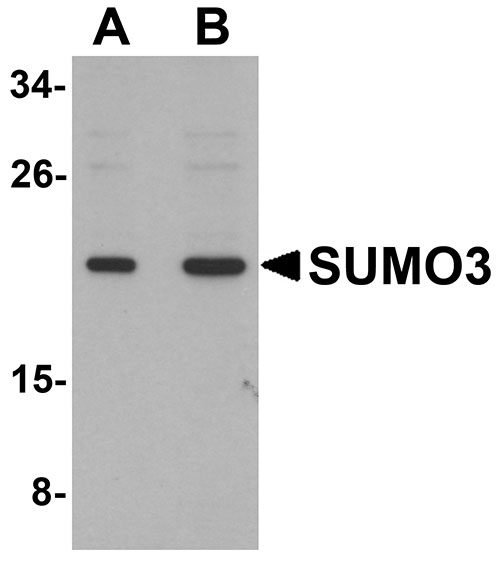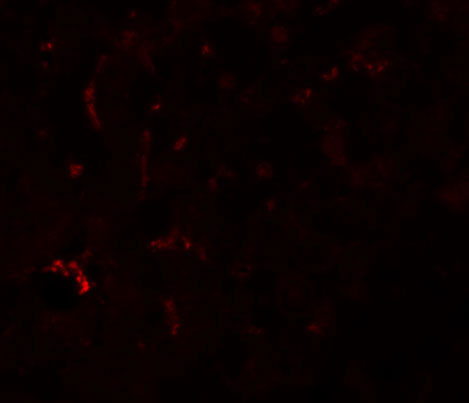SUMO3 Antibody
- SPECIFICATION
- CITATIONS
- PROTOCOLS
- BACKGROUND

Application
| WB, IHC-P, IF, E |
|---|---|
| Primary Accession | P55854 |
| Other Accession | NP_008867, 48928058 |
| Reactivity | Human, Mouse, Rat |
| Host | Rabbit |
| Clonality | Polyclonal |
| Isotype | IgG |
| Calculated MW | 11637 Da |
| Application Notes | SUMO3 antibody can be used for detection of SUMO3 by Western blot at 1 - 2 µg/mL. Antibody can also be used for immunohistochemistry starting at 5 µg/mL. For immunofluorescence start at 20 µg/mL. |
| Gene ID | 6612 |
|---|---|
| Target/Specificity | SUMO3; |
| Reconstitution & Storage | SUMO3 antibody can be stored at 4℃ for three months and -20℃, stable for up to one year. As with all antibodies care should be taken to avoid repeated freeze thaw cycles. Antibodies should not be exposed to prolonged high temperatures. |
| Precautions | SUMO3 Antibody is for research use only and not for use in diagnostic or therapeutic procedures. |
| Name | SUMO3 (HGNC:11124) |
|---|---|
| Function | Ubiquitin-like protein which can be covalently attached to target lysines either as a monomer or as a lysine-linked polymer. Does not seem to be involved in protein degradation and may function as an antagonist of ubiquitin in the degradation process. Plays a role in a number of cellular processes such as nuclear transport, DNA replication and repair, mitosis and signal transduction. Covalent attachment to its substrates requires prior activation by the E1 complex SAE1-SAE2 and linkage to the E2 enzyme UBE2I, and can be promoted by an E3 ligase such as PIAS1-4, RANBP2 or CBX4 (PubMed:11451954, PubMed:18538659, PubMed:21965678). Plays a role in the regulation of sumoylation status of SETX (PubMed:24105744). |
| Cellular Location | Cytoplasm. Nucleus. Nucleus, PML body |
| Tissue Location | Expressed predominantly in liver. |

Thousands of laboratories across the world have published research that depended on the performance of antibodies from Abcepta to advance their research. Check out links to articles that cite our products in major peer-reviewed journals, organized by research category.
info@abcepta.com, and receive a free "I Love Antibodies" mug.
Provided below are standard protocols that you may find useful for product applications.
Background
SUMO3 Antibody: Small ubiquitin-like modifiers (SUMOs) are a family of small, related proteins (Sumo-1/2/3/4) that can be enzymatically attached to a target protein by a post-translational modification process termed sumoylation, which is a major regulator of protein function in cellular processes such as nuclear transport, transcriptional regulation, apoptosis and protein stability. All SUMO proteins localize to the nucleus and are covalently conjugated, affecting protein structure, function and interactions. SUMO2 and 3 are 96% identical and are more mobile within nucleus relative to SUMO1. Specific functional differences between SUMO1 and SUMO2 and 3 remain to be identified.
References
Kamitani T, Kito K, Nguyen HP, et al. Characterization of a second member of the sentrin family of ubiquitin-like proteins. J. Biol. Chem.1998;273:11349-53.
Kim KI, Baek SH, and Chung CH. Versatile protein tag, SUMO: its enzymology and biological function. J. Cell. Physiol.2002; 191: 257-68.
Su H and Li SS. Molecular features of human ubiquitin-like SUMO genes and their encoded proteins. Gene2002; 296: 65.
Saitoh H and Hinchey J. Functional heterogeneity of small ubiquitin-related protein modifiers SUMO-1 versus SUMO-2/3. J. Biol. Chem.2000; 275:6252-8.
If you have used an Abcepta product and would like to share how it has performed, please click on the "Submit Review" button and provide the requested information. Our staff will examine and post your review and contact you if needed.
If you have any additional inquiries please email technical services at tech@abcepta.com.













 Foundational characteristics of cancer include proliferation, angiogenesis, migration, evasion of apoptosis, and cellular immortality. Find key markers for these cellular processes and antibodies to detect them.
Foundational characteristics of cancer include proliferation, angiogenesis, migration, evasion of apoptosis, and cellular immortality. Find key markers for these cellular processes and antibodies to detect them. The SUMOplot™ Analysis Program predicts and scores sumoylation sites in your protein. SUMOylation is a post-translational modification involved in various cellular processes, such as nuclear-cytosolic transport, transcriptional regulation, apoptosis, protein stability, response to stress, and progression through the cell cycle.
The SUMOplot™ Analysis Program predicts and scores sumoylation sites in your protein. SUMOylation is a post-translational modification involved in various cellular processes, such as nuclear-cytosolic transport, transcriptional regulation, apoptosis, protein stability, response to stress, and progression through the cell cycle. The Autophagy Receptor Motif Plotter predicts and scores autophagy receptor binding sites in your protein. Identifying proteins connected to this pathway is critical to understanding the role of autophagy in physiological as well as pathological processes such as development, differentiation, neurodegenerative diseases, stress, infection, and cancer.
The Autophagy Receptor Motif Plotter predicts and scores autophagy receptor binding sites in your protein. Identifying proteins connected to this pathway is critical to understanding the role of autophagy in physiological as well as pathological processes such as development, differentiation, neurodegenerative diseases, stress, infection, and cancer.




